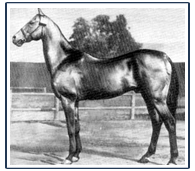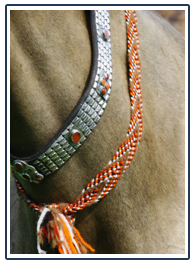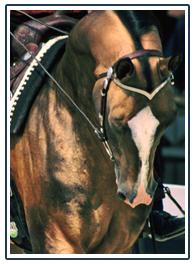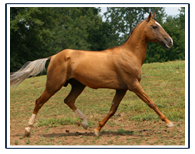
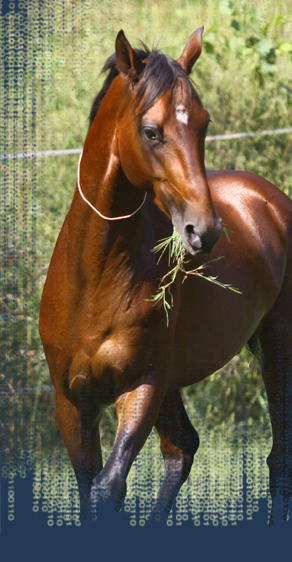
 |
||
|---|---|---|
The Akhal-Teke is an ancient, 3,000 year old breed originating from Turmenistan that is said to be the last pure strain of the original turkmene horse. The word Akhal-Teke emerged from the KaraKum desert from the “Teke” tribe that lived near the “Akhal” oasis. Recent DNA research from the University of Kentucky suggests that they are the oldest domesticated light breed of horse in the world. Slender, long legged equine remains have been found near the Caspian Sea that date back as far as 5,000 years. Throughout history, the Akhal-Teke ancestors have been known by many different names such as the Nisean, Turkoman, Turk, and Parthian. The horses were traditionally treasured as family members and slept in the tents of their owners, alongside their people. Three thousand years of use as raiding and war horses created excellent endurance and stamina as well as cat-like reflexes. Their movements are long and lateral, conserving energy on long treks. These Akhal-Teke horses developed a reputation for being the very best horses you could ever have and quests and wars were fought over them. Traditionally the tribesmen adorned their horses with ropes called alajas/aladjas. An aladja is used traditionally to ward against evil spirits and keep the horse safe. Additionally, metal collars made from silver and semi-precious stones were also fashioned and worn by their horses. A successful raider's horse would be seen to be wearing intricate bridles and collars all made from silver and gemstones as the horse's share of the "loot." When the Soviet Union invaded and took over the region, the horses were all but wiped from existence when times got hard and the Soviets ordered the horses slaughtered in order to feed the people. The Turkmenes refused to kill and eat their horses and, instead, set them loose in the desert. Because Akhal-Teke pedigrees were traidtionally orally kept, this meant that generations of ancestry was lost. As a result, the Akhal-Teke was robbed of modern day prominence as their numbers dwindled down to nothing. Gradually the value of the breed was realized and they were saved and bred as race horses. Many Akhal-Teke races are still held in Turkmenistan and Russia today. There are an estimated 5,000 worldwide and about 500 purebreds in North America. Despite relatively low population numbers in comparison to other sport horse breeds, several Akhal-Teke’s have been successful in the upper levels of the equestrian world and have competed at Grand Prix level dressage, the Advanced division in Eventing and in the Tevis in endurance. In 1979, the first Akhal-Tekes set foot on American soil when Phil and Margo Case imported the stallion, Senetir. Many of Senetir's offspring successfully competed in upper level Eventing and Dressage. Sengar and Kandar are two of such offspring worth noting as being short-listed for Olympic games during their three-day eventing careers. Akhal-Tekes are physically characterized as long, slender horses, with hooded eyes and long sleek ears. Their elegant necks are set high on the chest and they should be level across the topline. They are narrow chested but deep in the girth and are generally longer than they are tall. Average height for a Teke is between 15-16 hands tall though some are taller. They are a hot blood like their Arabian cousin but generally tend to be mellower in temperament. Teke’s are notorious for the deep bond which they form with their owners. Wonderful trail horses due to their smooth flowing gaits, the Akhal-Teke adapts well to which ever discipline is chosen for them. One of the most notable characteristics of the Akhal-Teke is their metallic coat color that attracts attention where ever they go. It is a result of a longer portion of the hair follicle being translucent. Palominos and buckskins seem to be actually made of molten gold as a result of this hair. All colors of Akhal-Tekes carry this trait to their coat but some seem to have more of a "shine" factor than others and it is not known how this is genetically passed on to offspring. Akhal-Tekes typically thrive on human companionship and form deep bonds with their people. They are also highly inteligent and sensitive and do not do well with harsh treatment. If a punishment for misbehavior does not seem "fair" they will often become insulted by it and act defensively as a result. A horse in the wrong hands that has been deemed "dangerous" will often become calm and friendly simply by the changing of handlers to someone who is better suited to their sensitivity and inteligence. For this reason, Tekes are not a horse for just anyone and do best with someone who is able to handle a sensitive horse who wants a strong relationship with their person.
|
|
|

